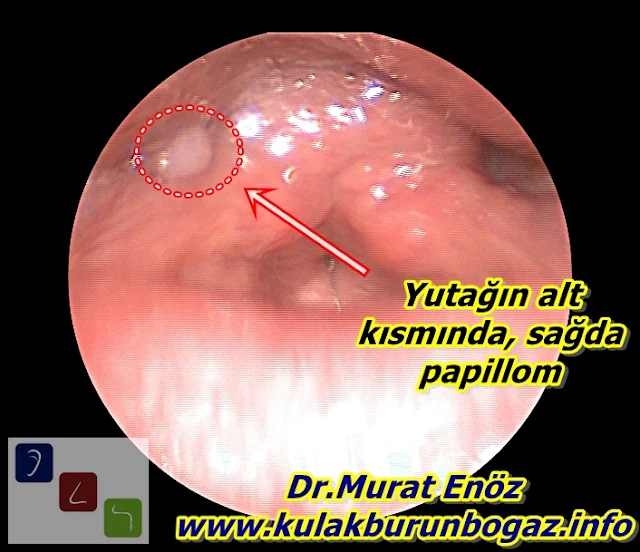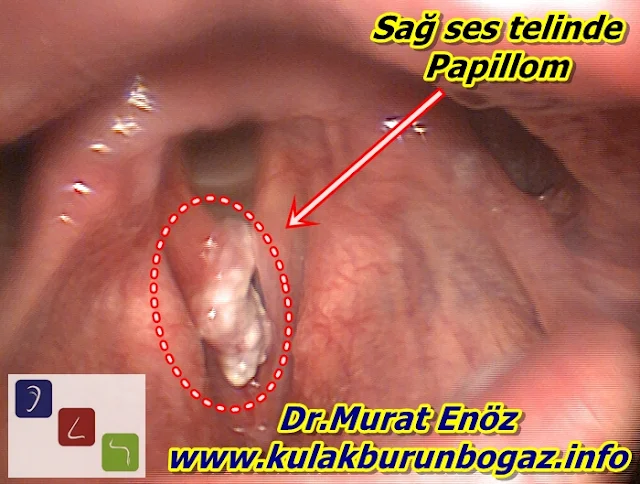Oral Human Papillomavirus (HPV) Infection More Common Now!
What is HPV?
Human Papillomavirus (HPV) are viruses that are sexually transmitted and cause "genital warts" among the public. More than 100 subtypes have been isolated. The vast majority (~ 85 to 90%) of HPV-positive oropharyngeal cancers are associated with HPV-16 and HPV-18 subtypes. The same two subtypes are positive in 70% of cervical cancers (cervical cancers) and precancerous cervical lesions. It is not necessary to have lesions in the throat area in all patients with HPV virus, and routine otolaryngological examinations may be normal.
How Is HPV Transmitted?
The reservoir for this virus is human (it can be found in other animals). Virus transmission can be sexually or directly through mucosal contact. Genital HPV infection can also be transmitted non-sexually, but this is rare. For example, transmission of a newborn baby from the mother during birth is a non-sexual form of transmission.
How to Understand HPV?
Most HPV infections are asymptomatic.
Clinical signs of HPV infection are:
- Anogenital warts
- Recurrent airway papillomatosis
- Cervical cancer precursor lesions (cervical intraepithelial neoplasia)
- Cancer (cervical, anal, vaginal, vulvar, penis and some head and neck cancers)
We have patients with no symptoms or hoarseness in the area of otorhinolaryngology, depending on the location of the infection, in HPV infections.
Who Has HPV Most Commonly?
Extensive studies on the subject show that HPV infection is associated with sexual behavior and the number of sexual partners. As the number of sexual partners increases, the risk of HPV infection increases. The ages below 25 have been shown to be a separate risk factor for infection. It has been reported that sexual intercourse at a young age, the use of irregular condoms, genetic factors, smoking, uncircumcision and the use of oral contraceptive drugs are separate risk factors.
What are the Types of HPV?
More than 150 subtypes have been isolated. There are also HPV-6 and HPV-11 subtypes that are low-risk and mostly cause genital warts. The high-risk (or carcinogenic) types are currently type 16, 18, 31, 33, 35, 39, 45, 51, 52, 56, 58, 59, 68, 69, 73, and 82 subtypes. HPV infection is also associated with cervical cancer as well as less common anogenital cancers such as cancer of the vulva, vagina, penis and anus. 5-30% of people with HPV infection in the mucous membranes are infected with multiple types of the virus. That is, infection with one type of HPV does not prevent another type of HPV infection.
How Does HPV Cause Problems?
 |
| In the photo above, the gums of the patient with widespread warts on the gums and mouth can be seen. |
People who are infected with the HPV virus may have no symptoms at all. In addition, many different lesions such as recurrent airway papillomatosis, genital warts, genital cancer precursor lesions, penile cancer and anal region cancer can be seen in the long term.
Sexually Active Men Need to Get HPV Vaccine!
Human Papilloma Virus (HPV), which is frequently referred to as the cause of cervical cancer in women, has been shown to cause cancers of the mouth, throat, tongue, upper esophagus, penis and anus in men. Planning this vaccine is recommended especially for sexually active men. It is reported that this vaccine is more appropriate, especially in those between the ages of 9-26 and who have never encountered HPV.
It is recommended that the HPV vaccine, which is the most effective means of defense against this virus, which can be found in men without clinical symptoms and condoms are not sufficient for protection, are also recommended for men. It is important to have this vaccine in order to prevent the way of transmission to women.
HPV Can Also Be Transmitted Orally!
It has been shown that the HPV virus can also be transmitted orally. It was once again emphasized that using condoms during sexual intercourse would not be sufficient in terms of protection for this virus, which can also be transmitted through the skin.
How is HPV Vaccine Made?
For HPV infection, it is very important to pay attention to the number of sexual partners and sexual behavior. Although the use of condoms reduces HPV infections; It has been shown that it cannot prevent it completely. Monogamy and having as few sexual partners as possible is the most appropriate strategy. Apart from this, it is important that HPV vaccination is given to both female and male patients at appropriate ages. Vaccines available on the market:
Gardasil (for 4 HPV types) - is protective for HPV 16 and 18 (high risk ones), HPV 6 and 11 (low risk ones). It is approved for use for boys and girls 9-26 years old.
At the end of 2014, the FDA approved the 9-valent HPV vaccine "Gardasil 9". Protection has also been added for additional 5 types of carcinogenic viruses (Sources: Gardasil 9 - Merck.com -
Press Announcements > FDA approves Gardasil 9 for ... -
GARDASIL 9 - Products - MerckVaccines.com).
Cervarix (for 2 HPV types) - is protective for HPV 16 and 18 (high risk ones). It is approved for use for boys and girls 10-25 years old.
Previous infection with one HPV type does not reduce the vaccine efficacy against other types of HPV.
The routine vaccination schedule is 0.2 and 6 months (the second vaccine should be given two months after the first vaccine and the remaining third dose 6 months after the first).
In the United States, articles about the need for Human Papilloma Virus (HPV) vaccination are published by many serious health organizations or health organizations such as family medicine association, cancer institute, food and pharmaceutical industry institution, infectious disease prevention committee.
Some of these organizations, who spoke against the exaggerated rhetoric about the swine flu vaccine, support HPV vaccination. I wanted to compile the answers to frequently asked questions about the HPV vaccine by citing different foreign sources. It should be emphasized that the HPV vaccine is the only tool that can be used in preventing cancer and precancerous lesions and preventing the spread of this virus. Debates continue about the vaccine's effectiveness, duration of action and possible unknown side effects.
Papilloma on The Tongue
Squamous papilloma or squamous cell papilloma are benign lesions that result from HOV infection, originating from squamous epithelium in the skin, lips, mouth cavity, tongue, pharynx, larynx, esophagus, uterus, vagina or anal canal. Most oral papillomas are usually the result of infection with type HPV-6 and HPV-11. Carcinogenic transformation is very rare. It is frequently seen in people between the ages of 30-50. (Source: Squamous cell papilloma - http://en.wikipedia.org/wiki/Squamous_cell_papilloma)
Papilloma on The Soft Palate and Uvula
Above is the throat photograph of the patient with a pedicled squamous papilloma at the border of the small tongue - soft palate due to HPV infection.
Papilloma of Uvula
Above is the throat photograph of the patient with a pedicled squamous papilloma on the uvula in contact with the base of the tongue due to HPV infection. Although very rare; It can cause sensation of stuck in the throat, difficulty swallowing and cough (Source: Symptomatic Squamous Papilloma of the Uvula: Report of a Case and
Review of the Literature).
Pharyngeal Papillom
Unlike laryngeal papillomas, pharyngeal papillomas are usually seen as single solitary lesions. Laryngeal papillomas are usually more than one grouped lesions (Source: Pharyngeal squamous cell papilloma in adult ... -
http://link.springer.com/article/10.1007/s00405-011-1908-0). Above, in the pharynx area, a single papilloma is seen on the right - lower side. It is an incidentally detected lesion in the patient. It does not cause any symptoms.
Vocal Cord Papilloma
Laryngeal papilloma (laryngeal papillomatosis) is also known as recurrent airway papillomatosis / recurrent respiratory papillomatosis / glottal papillomatosis. It is usually caused by HPV types 6 and 11. It may require repeat surgery and cause a blockage in the airway. During normal delivery, the occurrence of papillomas in the larynx after the infection of HPV virus from the mother to the respiratory tract of the baby is called “Juvenile Laryngeal Papillomatosis”. Transmission in this way is a form of "non-sexual transmission" for the HPV virus. It is a condition characterized by the appearance of numerous wart growths on the vocal cords in children and young adults. Recurrence is common with laryngeal papillomatosis. Remission can occur after a few years (Source: Juvenile laryngeal papillomatosis definition - MedicineNet - www.medicinenet.com/script/main/art.asp?articlekey=8990).
In the treatment of vocal cord papilloma, cryosurgery, laser therapy, antiviral therapy and interferon treatment are among the recommended treatment tools.
Vocal Cord Papillomatosis - Common Papillomatosis of the Larynx
Above, papillomatous lesions due to HPV infection are seen in the larynx. The complaint of hoarseness occurred due to permanent anatomical changes due to HPV infection. Repeated partial resections with laser were planned for the patient included in the vaccination program.
In laryngeal papillomatosis, carbon dioxide laser application is recommended to prevent scar, web and laryngeal web formation after the procedure. Although many antiviral drugs such as cidofovir are used in the treatment of laryngeal papillomatosis; none of them can definitely stop the growth of these lesions (Source: Laryngeal papillomatosis - Wikipedia, the free encyclopedia - http://en.wikipedia.org/wiki/Laryngeal_papillomatosis). In severe cases, interferon therapy can be used. In addition, speech therapy after laser application can be useful to assist with vocal hygiene and voice retraining.
Viral Papilloma of The Hard Palate
Above, on the right side of the hard palate, a viral papilloma lesion is seen. The excision was made under local anesthesia in office conditions, and silver nitrate was applied on it (2 photos in the iron). The intraoral view of the patient after 1 week is also available (from the 45 photos above, the bottom 2)
Papilloma of The Right Tonsil
How is HPV Treatment Done?
Treatment in HPV infection can be planned in 3 stages:
1.Treatment in patients with HPV infection and no symptoms
Close follow-up of the doctor and a vaccination program are important in these patients. Having an HPV infection is not an obstacle for vaccination.
2.Treatment in patients with HPV infection and tissue changes
3.Treatment of genital warts due to classical HPV infection
Murat Enoz, MD, Otorhinolaryngology, Head and Neck Surgeon
Private Office:
Address: İncirli Cad. No:41, Kat:4 (Dilek Patisserie Building), Postal code: 34147, Bakırköy - İstanbul
Appointment Phone: +90 212 561 00 52
Appointment Phone: +90 212 561 00 52
Fax: +90 212 542 74 47




















Comments
Post a Comment